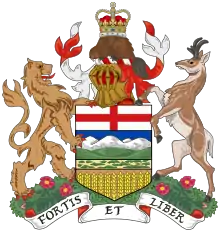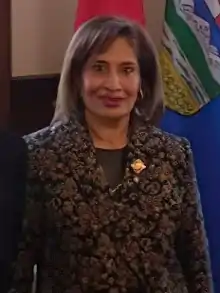| Provincial government | |
 Coat of arms of Alberta, used across the government (left); and the Alberta wordmark, used to corporately identify the executive (right) | |
| Formation | 1 September 1905 |
|---|---|
| Founding document | Constitution Act, 1867 Alberta Act, 1905 |
| Province | |
| Country | |
| Website | www |
| Crown | |
| Sovereign | Monarch |
| Vice-regal representative | Lieutenant Governor |
| Legislative (Crown-in-Parliament) | |
| Legislature | Alberta Legislature |
| Meeting place | Legislature Building, Edmonton |
| Executive (Crown-in-Council) | |
| Head of government | Premier |
| Appointed by | Lieutenant Governor |
| Main organ | Executive Council |
| Judicial (Crown-on-the-Bench) | |
| Court | Court of Appeal |
| Seat | Law Courts, Edmonton |
The government of Alberta (French: gouvernement de l'Alberta) is the body responsible for the administration of the Canadian province of Alberta. As a constitutional monarchy, the Crown—represented in the province by the lieutenant governor—is the corporation sole, assuming distinct roles: the executive, as the Crown-in-Council; the legislature, as the Crown-in-Parliament; and the courts, as the Crown-on-the-Bench. The functions of the government are exercised on behalf of three institutions—the Executive Council; the Legislative Assembly; and the judiciary, respectively. Its powers and structure are partly set out in the Constitution Act, 1867.
Alberta operates in the Westminster system of government. The political party or coalition that wins the largest number of seats in the legislature forms government, and the party's leader becomes premier of Alberta and ministers are selected by the premier.
In modern Canadian use, the term Government of Alberta refers specifically to the executive—political ministers of the Crown (the Cabinet/Executive Council) who are appointed on the advice of the premier. Ministers direct the non-partisan civil service, who staff ministries and agencies to deliver government policies, programs, and services. The executive corporately brands itself as the Government of Alberta, or more formally, His Majesty's Government of Alberta (French: Gouvernement de l’Alberta de Sa Majesté).
The Crown
King Charles III, as sovereign is also the King of Alberta. As a Commonwealth realm, the Canadian monarch is shared with 14 other independent countries within the Commonwealth of Nations.[6] Within Canada, the monarch exercises power individually on behalf of the federal government, and the 10 provinces.
The powers of the Crown are vested in the monarch and are exercised by the lieutenant governor. The advice of the premier and Executive Council is typically binding; the Constitution Act, 1867 requires executive power to be exercised only "by and with the Advice of the Executive Council".[7]
Lieutenant governor
The lieutenant governor is appointed by the governor general, on the advice of the prime minister of Canada.[11] Thus, it is typically the lieutenant governor whom the premier and ministers advise, exercising much of the royal prerogative and granting royal assent.
Powers and function
While the advice of the premier and Executive Council is typically binding on the lieutenant governor, there are occasions when the lieutenant governor has refused advice. This usually occurs if the premier does not clearly command the confidence of the elected Legislative Assembly, or if the advice or legislation would be unconstitutional.
Federally, a notable instance occurred in 1926, known as the King-Byng Affair, when Governor General Lord Byng of Vimy refused Prime Minister Mackenzie King's request to dissolve the federal Parliament to call for a general election.
More recently, on a provincial level in British Columbia following the 2017 provincial election, Premier Christy Clark met with Lieutenant Governor Judith Guichon and advised dissolution of the Legislature. Guichon declined Clark’s request. Clark then offered her resignation as Premier, and the leader of the Official Opposition, John Horgan, who was able to command the confidence of the elected Legislature, was invited to form the government.[12]
In 2022, Lieutenant Governor Salma Lakhani identified the constitutional role of the lieutenant governor as the most important part of the job. She stated "We are a constitutional monarchy, and this is where we do checks and balances. I’m what I would call a ‘constitutional fire extinguisher.’ We don’t have to use it a lot, but sometimes we do have to use it," in response to a proposed "Alberta Sovereignty Act" if it was determined to be unconstitutional. The proposed law would give the province the ability to ignore federal legislation it does not agree with.[13]
Executive power
The executive power is vested in the Crown and exercised "in-Council", meaning on the advice of the Executive Council; conventionally, this is the Cabinet, which is chaired by the premier and comprises ministers of the Crown. The term Government of Alberta, or more formally, His Majesty's Government refers to the activities of the Lieutenant Governor-in-Council. The day-to-day operation and activities of the Government of Alberta are performed by the provincial departments and agencies, staffed by the non-partisan public service, and directed by the elected government.[14]
Premier

The premier of Alberta is the primary minister of the Crown. The premier acts as the head of government for the province, chairs and selects the membership of the Cabinet, and advises the Crown on the exercise of executive power and much of the royal prerogative. As premiers hold office by virtue of their ability to command the confidence of the elected Legislative Assembly, they typically sit as a member of the Legislative Assembly (MLA) and lead the largest party or a coalition in the Assembly. Once sworn in, the premier holds office until either they resign or removed by the lieutenant governor after either a motion of no confidence or defeat in a general election.[15]
Danielle Smith has served as Premier since October 11, 2022, when she won the leadership of her United Conservative Party.[16]
Legislative power
The Legislative Assembly of Alberta is the deliberative assembly of the Alberta Legislature for the province of Alberta, Canada, and is seated at the Alberta Legislature Building in the provincial capital of Edmonton. The Legislative Assembly is a unicameral assembly of 87 members, elected first past the post from single-member electoral districts.[17] Bills passed by the legislature are given Royal Assent by Charles III, King of Canada, represented by the Lieutenant-Governor of Alberta.[18] The current Legislature is the 30th, since Alberta entered Confederation under the Alberta Act in 1905, and is composed of members elected in the April 16, 2019 general election, and returned a majority parliament controlled by the United Conservative Party commonly abbreviated to 'UCP'.
See also
References
- ↑ Claude Bouchard (16 February 2016). "Jugement No. 200-17-018455-139" (PDF) (in French). Cour supérieure du Québec. p. 16. Archived (PDF) from the original on 31 May 2020. Retrieved 17 February 2016 – via Le Devoir.
- ↑ Romaniuk, Scott Nicholas; Wasylciw, Joshua K. (February 2015). "Canada's Evolving Crown: From a British Crown to a "Crown of Maples"". American, British and Canadian Studies Journal. 23 (1): 108–125. doi:10.1515/abcsj-2014-0030.
- ↑ Department of Canadian Heritage (2015). "Crown of Maples: Constitutional Monarchy in Canada" (PDF). Her Majesty the Queen in Right of Canada. p. 3. Archived from the original (PDF) on 10 November 2012. Retrieved 16 February 2016.
- ↑ "Queen and Canada". The Royal Household. Archived from the original on 20 February 2009. Retrieved 16 February 2016.
- ↑ "The Queen of Canada". Government of Canada. Archived from the original on 24 February 2016. Retrieved 16 February 2016.
- ↑ [1][2][3][4][5]
- ↑ Branch, Legislative Services (2020-08-07). "Consolidated federal laws of canada, THE CONSTITUTION ACTS, 1867 to 1982". laws-lois.justice.gc.ca. Archived from the original on 5 June 2022. Retrieved 2021-04-03.
- ↑ Hicks, Bruce (2012). "The Westminster Approach to Prorogation, Dissolution and Fixed Date Elections" (PDF). Canadian Parliamentary Review. 35 (2): 20.
- ↑ MacLeod 2008, p. 36
- ↑ Government of Canada (4 December 2015). "Why does the Governor General give the Speech?". Queen's Printer for Canada. Archived from the original on 26 April 2018. Retrieved 17 December 2015.
- ↑ [8][9][10]
- ↑ "Lieutenant Governor". www.leg.bc.ca. Retrieved 2021-03-29.
- ↑ "Alberta's Lt.-Gov. says she's willing to toss Smith's sovereignty act if unconstitutional". edmontonjournal. Retrieved 2022-11-01.
- ↑ Neitsch, Alfred Thomas (2008). "A Tradition of Vigilance: The Role of Lieutenant Governor in Alberta" (PDF). Canadian Parliamentary Review. Ottawa: Commonwealth Parliamentary Association. 30 (4): 23. Archived from the original (PDF) on July 14, 2012. Retrieved May 22, 2009.
- ↑ "Parliamentary System". www.assembly.ab.ca. Retrieved 2022-11-01.
- ↑ "Smith stresses fight versus Ottawa, party unity after becoming Alberta's 19th premier". edmontonjournal. Retrieved 2022-11-01.
- ↑ "Legislative Assembly of Alberta". www.assembly.ab.ca.
- ↑ The Alberta Act, 4-5 Edw. VII [1905], c. 3 (Canada), s. 12 .
Works cited
- MacLeod, Kevin S. (2008), A Crown of Maples (PDF) (1 ed.), Ottawa: Queen's Printer for Canada, ISBN 978-0-662-46012-1, retrieved June 21, 2009
.jpg.webp)
